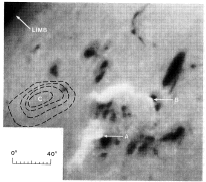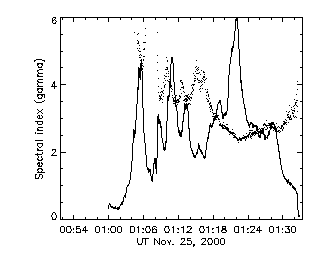
Coronal hard X-rays and millimeter waves
This will be the first of two Yohkoh science nuggets devoted to a remarkable flare now being studied by H. Takasaki of Kyoto University (and colleagues). It occurred in the November 2000 flare series but was quite different in nature. We often study must study coronal hard X-ray emission by using limb occultation ( [1], [2]), but in rare cases the coronal non-thermal effects become strong enough for direct study, as in this case.
From the Hinotori observations two decades ago, which pioneered hard X-ray imaging of solar flares, the late K. Tanaka suggested an "A, B, C" classification of solar flares. The A-flares would be "Atsui" (Japanese for "hot"); B-flares would be Bursts (impulsive events) and C-flares would denote Coronal events. This is less of a classification than a description of flare tendencies, since events will often mix these characteristics. However Hinotori did observe one exceptionally interesting C-type event, that of May 13, 1981 ([1], [2], [3]), which the current event may resemble. We'll review its (primitive!) observations in the next section. Our November 2000 event too can be thought of as a C-type event, and the second nugget (next week? several weeks from now?) will deal more extensively with the extremely interesting Nobeyama radio observations as well as Yohkoh data.
Here's a preview, showing hard X-rays (orange contours), millimeter waves (34 GHz; white contours) and soft X-rays (image):

The two images below show how this sort of thing appeared twenty years ago; H-alpha on the left and a 35-GHz one-dimensional image on the right:

|

|
The image on the left shows the hard X-ray contours "floating", due to perspective, above the H-alpha ribbons (arrows). The scan on the right (hard X-rays as a gray scale now) shows that the 35 GHz emission had a peak there in the corona, as well as (more typically) at the footpoints. Thus this event convincingly was a hard X-ray event seen on the disk, rather than by occultation.

The dotted points show the spectral index, 53-93 keV, and the solid line the burst intensity. There is a definite tendency for the burst component (B-type?) to diminish in importance, and for the hard gradual component (C-type?) to take over as time goes on. So, SHH please. That too is a characteristic of events of this type - note that half an hour has elapsed! These events are gradual, even at hard X-ray energies, despite the Neupert Effect! Also it is probably worthwhile for people to go back and read possibly the earliest paper on a related subject - on data from the TD-1 satellite, little remembered but appreciated by some.
March 29, 2002
H. Hudson, J. Sato and H. Takasaki (sato@solar.isas.ac.jp)